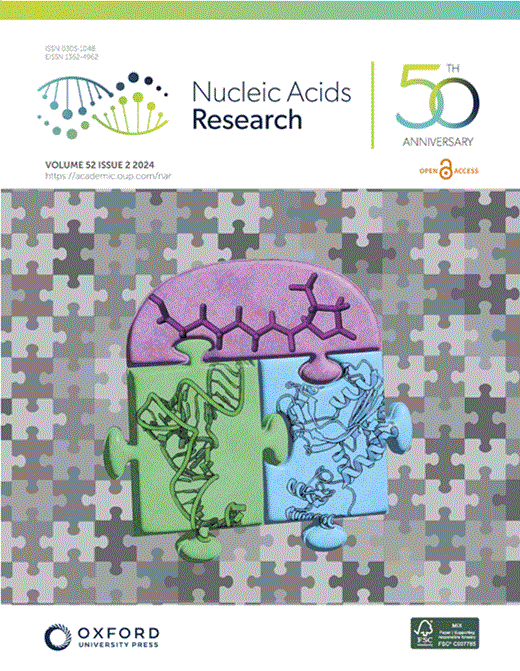Novel BRCA1–PLK1–CIP2A axis orchestrates homologous recombination-mediated DNA repair to maintain chromosome integrity during oocyte meiosis
IF 13.1
2区 生物学
Q1 BIOCHEMISTRY & MOLECULAR BIOLOGY
引用次数: 0
Abstract
Double-strand breaks (DSBs) are a formidable threat to genome integrity, potentially leading to cancer and various genetic diseases. The prolonged lifespan of mammalian oocytes increases their susceptibility to DNA damage over time. While somatic cells suppress DSB repair during mitosis, oocytes exhibit a remarkable capacity to repair DSBs during meiotic maturation. However, the precise mechanisms underlying DSB repair in oocytes remain poorly understood. Here, we describe the pivotal role of the BRCA1–PLK1–CIP2A axis in safeguarding genomic integrity during meiotic maturation in oocytes. We found that inhibition of homologous recombination (HR) severely impaired chromosome integrity by generating chromosome fragments during meiotic maturation. Notably, HR inhibition impaired the recruitment of CIP2A to damaged chromosomes, and the depletion of CIP2A led to chromosome fragmentation following DSB induction. Moreover, BRCA1 depletion impaired chromosomal recruitment of CIP2A, but not vice versa. Importantly, the impaired chromosomal recruitment of CIP2A could be rescued by PLK1 inhibition. Consequently, our findings not only underscore the importance of the chromosomal recruitment of CIP2A in preventing chromosome fragmentation, but also demonstrate the regulatory role of the BRCA1–PLK1–CIP2A axis in this process during oocyte meiotic maturation.新的BRCA1-PLK1-CIP2A轴在卵母细胞减数分裂期间协调同源重组介导的DNA修复以维持染色体完整性
双链断裂(DSBs)是对基因组完整性的巨大威胁,可能导致癌症和各种遗传疾病。随着时间的推移,哺乳动物卵母细胞寿命的延长增加了它们对DNA损伤的易感性。当体细胞在有丝分裂过程中抑制DSB修复时,卵母细胞在减数分裂成熟过程中表现出显著的修复DSB的能力。然而,对卵母细胞DSB修复的确切机制仍然知之甚少。在这里,我们描述了BRCA1-PLK1-CIP2A轴在卵母细胞减数分裂成熟过程中保护基因组完整性的关键作用。我们发现抑制同源重组(HR)通过在减数分裂成熟过程中产生染色体片段严重损害染色体完整性。值得注意的是,HR抑制抑制了CIP2A向受损染色体的募集,并且CIP2A的耗尽导致DSB诱导后染色体断裂。此外,BRCA1缺失会损害CIP2A的染色体募集,反之则不会。重要的是,抑制PLK1可以挽救受损的CIP2A染色体募集。因此,我们的研究结果不仅强调了染色体募集CIP2A在防止染色体断裂中的重要性,而且还证明了BRCA1-PLK1-CIP2A轴在卵母细胞减数分裂成熟过程中在这一过程中的调节作用。
本文章由计算机程序翻译,如有差异,请以英文原文为准。
求助全文
约1分钟内获得全文
求助全文
来源期刊

Nucleic Acids Research
生物-生化与分子生物学
CiteScore
27.10
自引率
4.70%
发文量
1057
审稿时长
2 months
期刊介绍:
Nucleic Acids Research (NAR) is a scientific journal that publishes research on various aspects of nucleic acids and proteins involved in nucleic acid metabolism and interactions. It covers areas such as chemistry and synthetic biology, computational biology, gene regulation, chromatin and epigenetics, genome integrity, repair and replication, genomics, molecular biology, nucleic acid enzymes, RNA, and structural biology. The journal also includes a Survey and Summary section for brief reviews. Additionally, each year, the first issue is dedicated to biological databases, and an issue in July focuses on web-based software resources for the biological community. Nucleic Acids Research is indexed by several services including Abstracts on Hygiene and Communicable Diseases, Animal Breeding Abstracts, Agricultural Engineering Abstracts, Agbiotech News and Information, BIOSIS Previews, CAB Abstracts, and EMBASE.
 求助内容:
求助内容: 应助结果提醒方式:
应助结果提醒方式:


